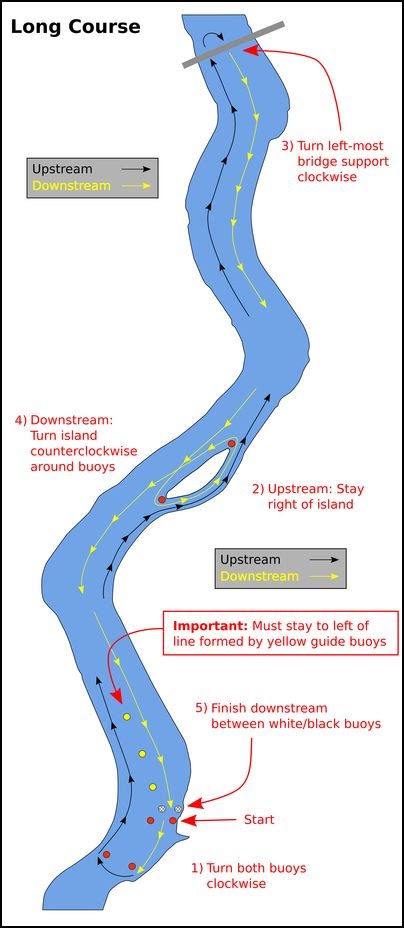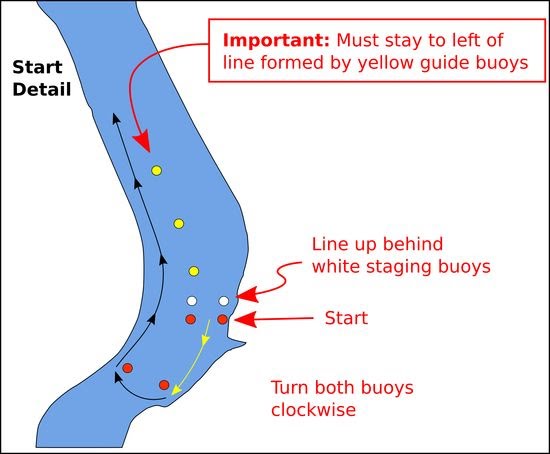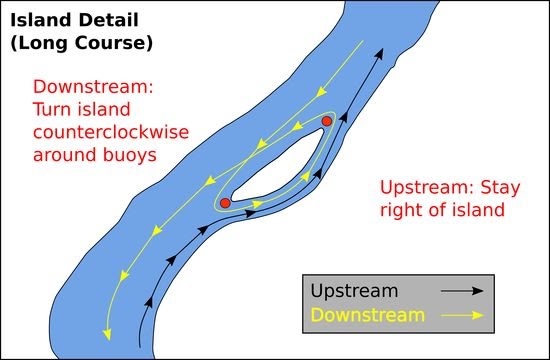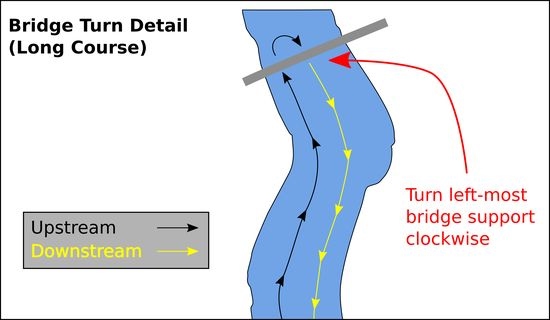Today I paddled the USCA National Championships marathon class in Northfield Massachusetts. I wasn’t originally going to do it, but after DNFing at the Gorge Downwind Championships and then finding out that I’m going to have to have carpal tunnel surgery in October, I figured I needed to do every race I could get my hands on this fall just in case next year is a wash-out.
I found a video online showing the course. It was up and down a river, so it was nice and flat, although a bit shallow and weedy. I could easily have managed it in my V12, but I’m still not convinced I’m any faster in the V12 than in the V10 Sport. Plus I have a very short rudder for the V10 Sport, and I haven’t paddled the V12 since I got back from out west. So I decided to paddle the Sport.
One odd “feature” of this race is that the K1 Unlimited class races on Friday. Most of my races are on weekends, but they’ve got a full calendar on this event, with sprint races on Thursday and other class races on Saturday and Sunday.
Another “feature” is that you have to be a member of USCA. Since I had no reason to join USCA other than this race, that makes this race really expensive for what it is.
Now there are at least two places on the website where it says that if you want to register, you either have to pre-register by mail before July 25th, or you have to register the day before the race before 6pm. Well, I didn’t make the decision to go until after the July 25th deadline, so I resigned myself to coming up early enough on Thursday to register. But then on Facebook, they said: “oh no, it doesn’t say that you can’t register after July 25th, it says if you pre-register by the 25th, you get a discount”. Well, it does say that in one place, but like I said, there are at least two places where it says the registration must be received by the 25th. But no matter – not the first time I’ve seen a race website that was contradictory and wrong. If they’re saying on Facebook that they’ll accept registrations now, I’m throwing one in the mail. And a couple of days later I got a confirmation that they’d received it. So that meant I could leave later on Thursday.
Once I was registered, it was time to book accommodation. The website for the event had a list of place to stay, but most of them were B&Bs or full houses. There was a motel near the event site, but they were full. So I booked another hotel on the list that was really cheap. And after I booked it, Vicki said: “how are their ratings on TripAdvisor”. Oh, I’d never thought to look. And man, I’m glad I did, because all the ratings were one and two stars, with frequent complaints about boarded up windows and trash. According to those ratings, the place had turned into a shit-hole after they’d put up a bunch of homeless people. (No offence to homeless people, but just parking them in a motel in the middle of nowhere is probably not the best solution for them.) Anyway, I quickly booked a much more expensive but more highly rated hotel. Afterward, I realized that as a single guy traveling alone, an AirBnB might have been a better and cheaper idea. Oh well. I heard some bad stories from people at the event about local AirBnBs as well.
Jim was also going to be here, but he’d come up well in advance. He wanted to paddle in the Sea Kayak class tomorrow, so he had to borrow a V8 from somebody, and that somebody didn’t want to go without his V8 for a whole week, so I ended up bring it up yesterday. Not a problem.
So on to the race. The weather forecast yesterday had said there might be thunderstorms in the morning, but when I woke up that had changed to a chance of thunderstorms in the afternoon. So that was a bullet dodged. It was sunny and hot. Too hot. There was a bit of a breeze running up the river. I found out after the race that there was a hydropower pumping station just downstream of the event and when it’s discharging (like it’s going to do on a hot day when everybody is running their air conditioners), it can actually reverse the local flow of the river. That actually explains some of the things I saw out there because my speed was pretty slow while going ostensibly “downriver” and I didn’t think it was only due to the breeze.

The race itself was pretty well organized. There were a lot of paddlers, so even though they used much narrower age categories than, say, Armond Bassett, unlike Armond Bassett there weren’t only 2 or 3 paddlers in every class. There were 16 people in my age category in unlimited K1. We were in the second start wave (which the announcer insisted on calling “heats” rather than “waves”, which is weird), along with young and fast paddlers and the slightly older than them but younger than us category. So about 50 paddlers on the line in our heat. There was a slight delay in the start as they repositioned one of the downstream turning buoys – it looked from our vantage point that they were moving it more off shore to give some room. The Women’s C1s started in the first wave, and we could watch them head down to the turning buoys about a kilometer downstream. We started before most of them had made their turns.

We headed down and things were pretty chaotic at first. Everybody was trying to find their best group to paddle with and still get around the two downstream buoys with a minimum of banging and barging. And considering the size of the field and the narrowness of the space between the buoys and the shore, I think it went off pretty well. As we turned the second buoy and started the long drag upstream (with a breeze at our back so we were in the still hot air), I found myself on the side wake of a guy with a nice looking Stellar surf ski. There was a guy who I’d noticed before the start, thinking “oh, at least I’ll be able to beat him”, and he was on the Stellar guy’s stern wake. So much for first impressions. I think he was in a V10L. The three of us basically maintained that formation most of the way up the river – Stellar guy and I were side-by-side and so I’d try to take a pull for a while and then I’d drop back and just ride for a while. There was another guy just a few boat lengths ahead of us and when I took my pulls I thought about trying to bridge the gap but I just couldn’t do it. I was maxed out, with heart rates in the low 160s. A few boat lengths ahead of that guy was a large pack of kayakers, including Wesley Echols. I really wish I could have gotten up to that pack because that would have been a good ride.
I was kind of shocked to see Jim heading back when I was at about 4km or so. I figured he must have had a mechanical problem, although he said afterward it was actually a problem with his hand or wrist. He’s been having problems with that recently, so I guess even he is finally feeling the effects of age.

On the way up, we had to go through a narrow channel between an island and the shore, and it was shallow and weedy in there. Stellar guy for some reason decided to try to get in tight to the shore, but I could see big mats of weeds there so I stayed in the middle of the channel, and he soon came back out and rejoined me and the V10L guy.
Not long after the island, Wesley started dropping back. He seemed to stop to backpaddle to get some weeds off, then started out not as fast as he had before. He joined up with the Stellar guy (since Wesley is a Stellar rep, I’m not surprised that they knew each other) and I let them paddle side by side while I took Stellar guy’s stern wake, although eventually, I ended up on Wesley’s because it looked like he was going to make a move go get back to that big pack. We’d put in a small gap on V10L guy, although a couple of times he fought his way back up to my stern wake. I still couldn’t recover, it was just too hot and humid. I wanted to get my heart rate into the 150s, which I know is where I need to be if I don’t want to blow up, but the only way I could do that would be to lose Wesley and the other guy’s wakes.

The upstream turn was on a bridge abutment. I think we had a solid gap on V10L guy by then, but Wesley, Stellar guy and I were neck and neck. Turning into the breeze felt really good, although it was slowing us down something fierce. I was now on Wesley’s side wake and even tried to take a few short turns leading him. I didn’t even notice when we lost Stellar guy, but Wesley and I both seemed to notice it at the same time, and he suddenly put the hammer down (or I died a little, not sure which) and he was off. He got a good gap on me and I figured he was gone for good. But at least now I could get my heart rate down out of the 160s.
On the way down, we had to do a loop of the island, repeating our trip up the narrow channel. In a way, this was an enormous drag, but it did add some interesting features to the racing. As I was passing the outlet to the channel on my way down, a group of faster paddlers came out of the channel heading downstream and I managed to jump on the wake of the last of them and ride them for a few minutes. Then it was “drag my way up the channel and emerge back into the downstream for the final section”, but as I was nearing the channel entrance a group of three C1s, the first of the open men C1s, came roaring by. The first guy tried to scrape the other two off on me, and the third one banged his paddle into my boat repeatedly before he dropped off. But in the process, they basically cut me off directing me to the entrance to the channel again, which I did not want to do. I had to stop paddling and let them go by so I could continue downstream. I was annoyed at the time, but hey, it’s all racing, right? That first guy was using good tactics against his two rivals even if it wasn’t good for me.
By the time we were in the last part heading downriver, it was shockingly sow – I was working as hard as I ever do and only managing speeds in the high 9s, low 10s. In still water and still air, even as fatigued as I was, I should have been doing mid to high 10s. One time I looked at my heart rate and it was down in the 140s, which seemed crazy low. Wesley was having real problems. I don’t know if he was cramping up or having balance issues, but every time I looked in his direction he seemed to be bracing. I was slowly catching him back up, and as I put in more effort my heart rate was back in the high 150s where I expected it to be. I hit the first of the yellow buoys, which I’d measured before the race as being 750 meters from the finish and I was about 2 boat lengths behind Wesley and closing fast when he suddenly turned his boat slightly and looked back and saw me, and he put in a big burst of speed. I had no finish sprint in me and I finished a few lengths behind him.
After clearing the finish line, I joined a bunch of other surf ski paddlers who were jumping out of their boats and swimming to cool off. What a great relief that was!
After the race, I was standing near my boat when one of the safety officials came over and yelled at me for having a Mocke PFD. According to him, USCA rules require US Coast Guard Approved PFDs only. Never mind that Mocke vests are ISO standard approved, and accepted by every canoe and kayak and surf ski organization in the world, and never mind that this river was so shallow and still that in the unlikely event that I somehow got separated from my boat I could have walked to shore, he said “I don’t know anything about what ISO means, just that it’s not American” or something like that, and he also said “Don’t you dare come back here without a Coast Guard approved vest”. It annoys the piss out of me that I can wear a Mocke PFD in the hairiest ocean races and through Swell City on the Gorge – places where I might legitimately have to make a remount or two, but here in flatsville I have to carry any old piece of shit that has a USCG approval sticker on it.
Now I found a web page that says that the USCA does allow the Mocke, Vaikobi, and other ISO approved PFDs, but only if they’re worn, not if they’re on the boat. (And this isn’t on the USCA page, so it’s possible this is just a proposed change that never got applied.) But it was too damn hot to wear it. One guy I talked to afterward said he’s going to take an old USCG approved PFD, unstitch it, take out half the floatation, stitch it back up, and use that as his (in the boat) PFD. I don’t recommend that. At some races in Australia, I’ve heard they have a very simple test – they attach a 5kg weight to your PFD and throw it in the water. If it floats, it’s a 50 Newton PFD and so, therefore, legal. (5kg of mass exerts approximately 50 Newtons of downward force in standard earth gravity.)
So after that bit of annoyance, the next part was even more annoying. When I picked up my race number this morning, they were out of goodie bags and shirts. So I had to wait for registration to re-open. And that wasn’t supposed to happen until after results were up. So I waited for the results to come up. And waited, and waited, and waited. Finally, at 4pm, 5 hours after I finished, they said “we still don’t have results, but we’re going to give the first, second and third place prizes now”. I knew I wasn’t getting any of them, so I took a chance and wandered over to registration and sure enough they were open and giving out goodie bags. If I’d known, I could have gone back to my hotel, had a shower, had a nap, and still returned in time for them to not have results up.
So anyway, this was a pretty good event, right up until the finish. The venue wasn’t perfect, I would have preferred deeper water and fewer weeds. But the start was well organized, the course was interesting, the loop around the island was an interesting wrinkle, and everything was well marked and clear. The onshore area was shaded and very pleasant, and they had good PA and there were some good food trucks. They even had adequate parking, although some people had to park a ways away. It was just too bad that they screwed up so badly on the results, and that their safety guy was such a jerkwad about the PFD issue.
Update: The USCA magazine has a write-up of the race from a racer’s point of view. Reading it, it’s obvious it was the guy I referred to above as “Stellar Guy”, but a photo credit in the article identifies him as Steve Horney. Here’s what he wrote:
I latched on to one racer who was making good time, then about halfway up the river we switched places and he drafted me until we caught up with Wesley Echols (who appeared to be having a tough time of it in the heat). We all ran together to the bridge where after making the turn and beginning the trip back I opted to suck down an energy gel pack. Somehow the energy transferred to Wesley and the other guy; they took off like a shot, and I was no more energized than I was before.
I guess that explains where he vanished to after the turn, but it’s interesting how he thought we were only traded leads once and I thought we were trading more often than that.





